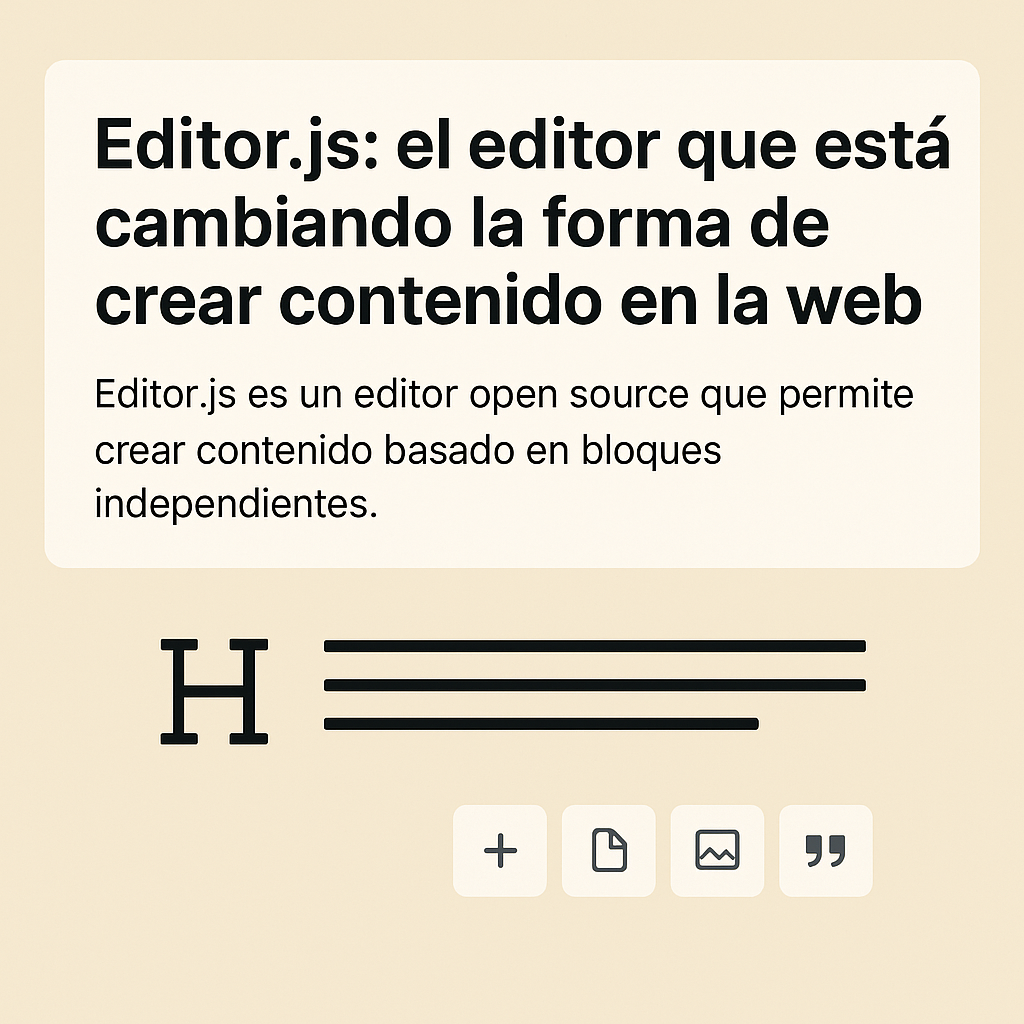el editor que está cambiando la forma de crear contenido en la web
Cuando hablamos de editores de texto para la web, lo normal es pensar en un “campo grande” tipo Word: escribes, das formato y listo. Editor.js le da la vuelta a ese concepto: en lugar de un documento de texto plano, te permite construir bloques independientes que luego se pueden reorganizar, enriquecer y exportar a JSON.
¿Qué es exactamente?
Editor.js es un editor open source en JavaScript que produce un JSON estructurado en lugar de HTML desordenado. Cada párrafo, imagen, vídeo o cita es un bloque. Esto facilita:
- Guardar el contenido en base de datos sin tags extraños.
- Renderizarlo donde quieras (web, app móvil, etc.).
- Añadir o quitar tipos de bloques sin romper nada.
Ventajas que enamoran
- Contenido limpio: obtienes datos puros, perfectos para APIs.
- Experiencia modular: arrastra y suelta bloques, reordénalos como quieras.
- Extensible: hay plugins para galerías, embeds, tablas… y puedes crear los tuyos.
- Ligero y rápido: solo carga lo que necesitas.
Integración en tu proyecto PHP o JS
- Instala con npm o carga desde CDN:
<script src="https://cdn.jsdelivr.net/npm/@editorjs/editorjs@latest"></script>- Inicializa:
const editor = new EditorJS({ holder: 'editorjs', tools: { header: { class: Header, inlineToolbar: true } } });- Guarda en tu base de datos:
editor.save().then((outputData) => { // outputData es JSON: guárdalo vía fetch/AJAX });
Ideas para tu web
- Blog modular: almacena contenido estructurado para mostrar en web, app o boletines.
- CMS ligero: combínalo con tu MVC en PHP para tener un editor moderno sin depender de WordPress.
- Notas colaborativas: gracias a su formato JSON, es perfecto para apps en tiempo real.
Conclusión
Si buscas un editor que hable el idioma de las aplicaciones modernas (datos bien formateados, flexibilidad y UX limpia), Editor.js es una apuesta ganadora. En mi caso, ya lo estoy usando en el backoffice de mis proyectos para que los redactores trabajen sin pelearse con HTML.

EL EDITOR PERMITE UN CONJUNTO DE HERRAMIENTAS EXTRAS.
Embed Tool
Provides Block tool for embedded content for the Editor.js. Tool uses Editor.js pasted patterns handling and inserts iframe with embedded content.
List of services supported
service — is a service name that will be saved to Tool's output JSON
- Facebook -
facebookservice - Instagram -
instagramservice - YouTube -
youtubeservice - Twitter -
twitterservice. (official twitter api is used for render, no need to use twitframe) - Twitch -
twitch-videoservice for videos andtwitch-channelfor channels - Miro -
miroservice - Vimeo —
vimeoservice - Gfycat —
gfycatservice - Imgur —
imgurservice - Vine -
vineservice. The project is in archive state now - Aparat -
aparatservice - Yandex.Music -
yandex-music-trackservice for tracks,yandex-music-albumfor albums andyandex-music-playlistfor playlists - Coub —
coubservice - CodePen —
codepenservice - Pinterest -
pinterestservice - GitHub Gist -
githubservice - 👇 Any other customized service
Installation
Get the package
yarn add @editorjs/embedInclude module at your application
import Embed from '@editorjs/embed';Optionally, you can load this tool from CDN JsDelivr CDN
Usage
Add a new Tool to the tools property of the Editor.js initial config.
var editor = EditorJS({
...
tools: {
...
embed: Embed,
},
...
});Available configuration
Enabling / disabling services
Embed Tool supports some services by default (see above). You can specify services you would like to use:
var editor = EditorJS({
...
tools: {
...
embed: {
class: Embed,
config: {
services: {
youtube: true,
coub: true
}
}
},
},
...
});Note that if you pass services you want to use like in the example above, others will not be enabled.
Add more services
You can provide your own services using simple configuration.
First, you should create a Service configuration object. It contains following fields:
Example:
{
regex: /https?:\/\/codepen.io\/([^\/\?\&]*)\/pen\/([^\/\?\&]*)/,
embedUrl: 'https://codepen.io/<%= remote_id %>?height=300&theme-id=0&default-tab=css,result&embed-version=2',
html: "<iframe height='300' scrolling='no' frameborder='no' allowtransparency='true' allowfullscreen='true' style='width: 100%;'></iframe>",
height: 300,
width: 600,
id: (groups) => groups.join('/embed/')
}When you create a Service configuration object, you can provide it with Tool`s configuration:
var editor = EditorJS({
...
tools: {
...
embed: {
class: Embed,
config: {
services: {
youtube: true,
coub: true,
codepen: {
regex: /https?:\/\/codepen.io\/([^\/\?\&]*)\/pen\/([^\/\?\&]*)/,
embedUrl: 'https://codepen.io/<%= remote_id %>?height=300&theme-id=0&default-tab=css,result&embed-version=2',
html: "<iframe height='300' scrolling='no' frameborder='no' allowtransparency='true' allowfullscreen='true' style='width: 100%;'></iframe>",
height: 300,
width: 600,
id: (groups) => groups.join('/embed/')
}
}
}
},
},
...
});Inline Toolbar
Editor.js provides useful inline toolbar. You can allow it`s usage in the Embed Tool caption by providing inlineToolbar: true.
var editor = EditorJS({
...
tools: {
...
embed: {
class: Embed,
inlineToolbar: true
},
},
...
});Output data
{
"type" : "embed",
"data" : {
"service" : "coub",
"source" : "https://coub.com/view/1czcdf",
"embed" : "https://coub.com/embed/1czcdf",
"width" : 580,
"height" : 320,
"caption" : "My Life"
}
}

